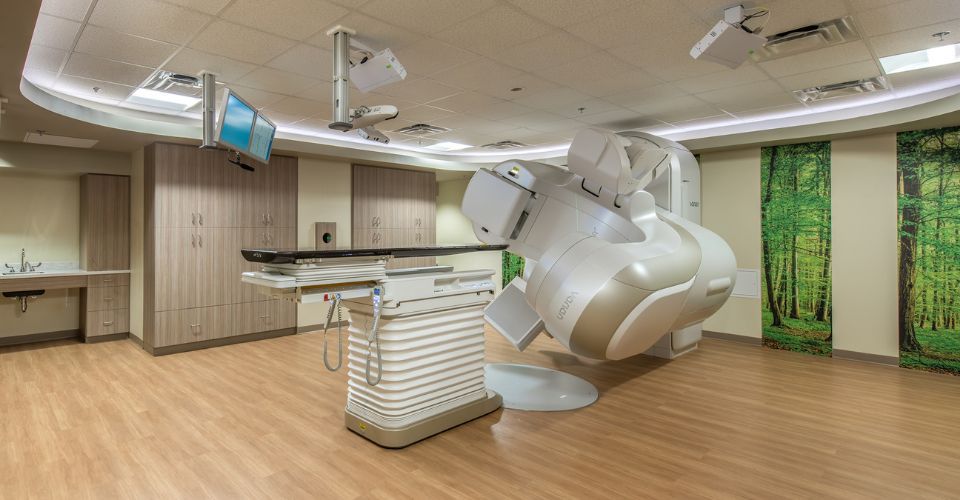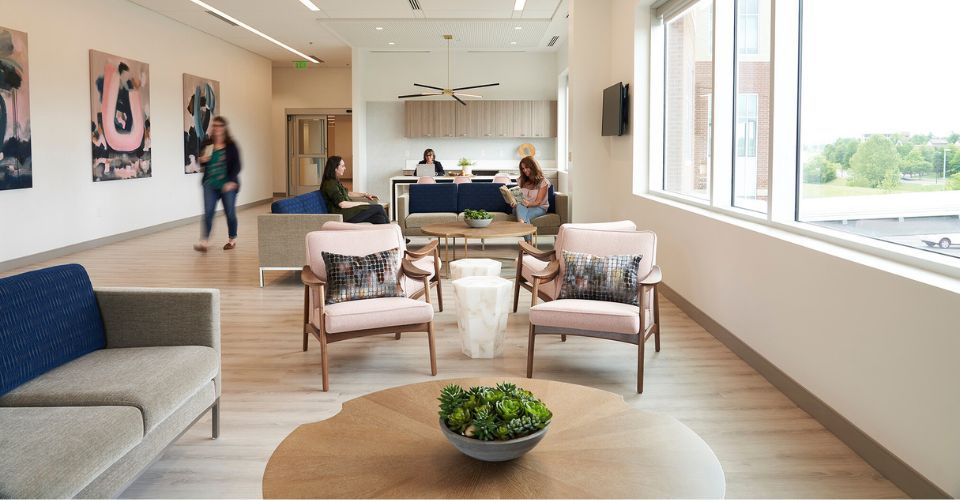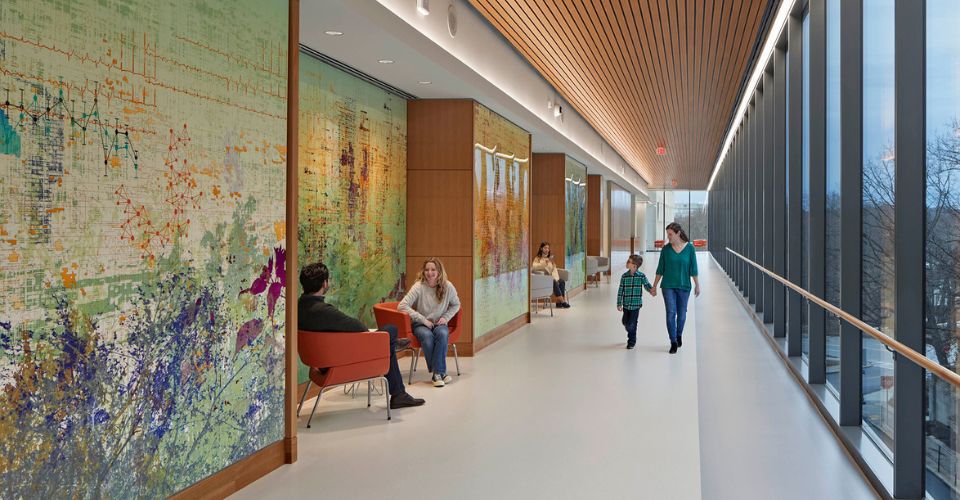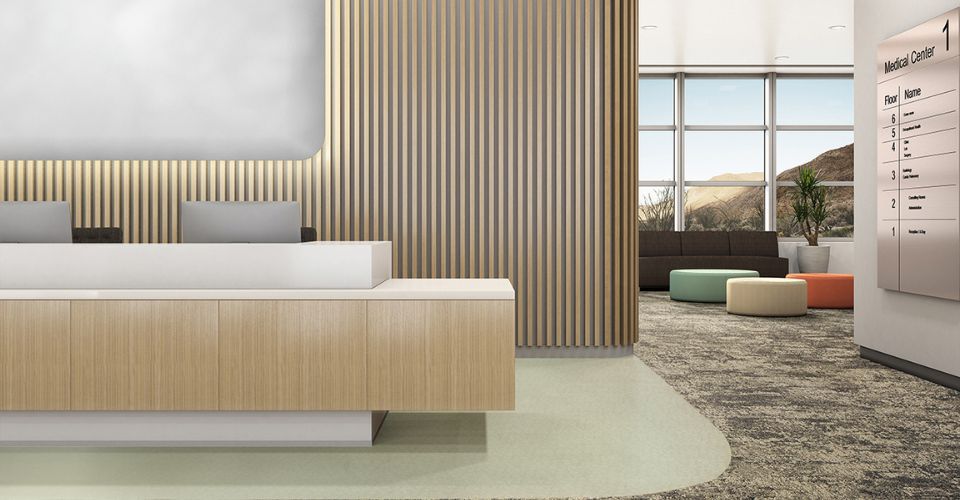The benefits of biophilic design represent a huge opportunity for healthcare facilities to improve the patient and caregiver experience. In our second blog exploring The Economics of Biophilia, we take a deeper look at how incorporating biophilic elements in healthcare design can positively impact both patients and staff in ways that can also offer financial benefits for facilities.
The Changing Role of Design in Healthcare
Historically, design has been viewed as a cost center rather than a revenue generator in many categories, including healthcare. It was common for decision-makers to view design as being focused solely on aesthetics, and most never really considered that the perception of a space could serve a greater purpose. However, in recent decades, this narrative has begun to shift, and we’ve realized the built environment’s impact on outcomes is greater than previously thought. We now understand that design decisions affect how occupants experience a space, and this in turn can affect a facility’s bottom line.
With experts estimating that healthcare costs are as much as 60% higher in the U.S. than in comparable countries, today’s healthcare facilities face increasing pressure to improve efficiency – often leading to compromises that negatively impact the patient experience.The good news is that biophilic design offers an opportunity for facilities to improve the experiences patients and caregivers have within healthcare environments.

Interiors: Design Innovations, Construction: Batson Cook, Photo: JandDimages
How Biophilic Design Benefits Patients
In 1984, Robert Ulrich, one of the first to research the impacts of biophilic design, conducted a landmark study that compared the recovery rates of patients with views of nature to those with views of an exterior wall of another hospital wing. His findings showed that patients with natural views had an average length of stay that was 18 hours shorter than patients with no natural views.
Ulrich’s work has inspired research into the effects of other biophilic design principles on patients. These studies found that patients benefited from brighter rooms and more access to daylight, views to the outside (both real and simulated), and exposure to plants – with subjects experiencing faster healing times or shorter hospital stays.
Subsequent studies have shown that introducing biophilic design elements into healthcare settings can lead to a host of benefits, including more positive health outcomes, better pain and stress management, and better staff performance – all of which contribute to how occupants regard a facility. In fact, research into the effect of biophilic design on patient experience found that rates of patients who responded “would definitely recommend this facility” on evaluations improved between 6.1% and 12.4% for those exposed to biophilic interventions.

Architect/Design: Gresham Smith, ©2019 McGinn Photography
How Biophilic Design Benefits Staff
Patients aren’t the only occupants of heathcare facilities – caregivers and staff argueably spend the most time in these environments. Employee wellbeing and performance directly impact the patient experience, and with over half of nurses reporting their mental and physical health as “suboptimal,” it is essential that healthcare facilities prioritize wellness and make choices that position staff for success. Thankfully, implementing biophilic design principles can postively impact caregivers and staff in addition to patients, facilitating stress recovery and fostering excellent performance.
Research shows a strong connection between staff performance and access to nature – including outdoor views and natural lighting. One study found that redesigning an ICU to incorporate more outdoor views and daylight led absentee rates to drop by 39.5%, while staff vacancies decreased by 25%. Investigators also saw a correlation between the use of outdoor break spaces and resiliency among nurses.

© Robert Benson Photography
Connecting Improved Experiences to the Bottom Line
It’s clear how biophilic design attributes contribute to an improved patient and caregiver experience, but how does this then translate to increased profitability? The answer is threefold and relates to shorter patient stays, higher patient survey scores, and lower staff turnover.
Shorter Stays = Savings: Studies have found that biophilic interventions can help reduce an inpatient’s length of stay by anywhere from 4.9% to 33.3% — resulting in an average decrease of 18%, which is around one day shorter. When these types of findings are extrapolated using healthcare industry averages, the savings are significant. Using 2016 figures, if a hospital could reduce every inpatient’s stay by one day, the resulting annual inpatient savings would be more than $12.3 million. Furthermore, that time savings would turn into the opportunity to see more patients and bring in additional revenue.
Higher Ratings = More Reimbursements: The passing of the Affordable Healthcare Act of 2010 more closely tied a hospital’s perceived quality of care to the amount of payer reimbursements received from insurance companies as part of the Hospital Value-Based Purchasing program. As a result, patient experience is more important than ever – in fact, it accounts for 25% of a hospital’s quality of care score and is calculated by patient surveys, translating higher evaluations into larger payouts.
Estimates from a 2017 study calculated that for every 1% increase in “would definitely recommend” on patient evaluations, a facility receives a net increase of $247,000 in income, $1,072,000 in patient revenue and a 0.04% rise in operating margins. By these estimates, even a modest 3.4% increase in “would definitely recommend” evaluation responses from patients could result in a $3.6 million increase from inpatient revenue and a 0.14% rise in operating margins.
Lower Turnover = Lower Costs: Labor costs account for around 55% of total hospital costs, which makes improving staff performance and productivity a considerable opportunity for enhanced profits. However, worker stress and burnout are two of the most significant and costly obstacles to overcome before facilities can increase profits. It’s estimated that replacing a single nursing position can cost a facility twice the position’s annual salary, while nursing turnover can account for as much as 5% of a hospital’s annual operating budget.
Efforts to decrease staff turnover rates can vastly improve operating expenses. A 25% decrease in staff turnover alone would recapture 1.25% of a facility’s annual operating budget. Patients would also benefit from healthier and happier staff, further enhancing revenue opportunities.
Expanding the Benefits of Biophilia in Healthcare
Given the positive impacts associated with biophilic design, particularly with quality vews and daylighting, and the financial benefits that can be tied to improving the patient and caregiver experience, it is no surprise that the healthcare industry has shown momentum toward incorporating biophilic design principles into interiors. While most research on the topic has centered on acute-care hospitals to date, it is likely that similar benefits can be realized within outpatient-focused facilities. Fortunately, as more large healthcare networks reap the benefits of biophilic design in their hospitals, it is natural that similar design principles will be applied to their outpatient offices and will be incorporated into healthcare spaces of all specialties and sizes.
In the final installment of this series, we will explore key findings from The Economics of Biophilia for the workplace. If you missed the first part, which looked at education facilities, you can read it here.
